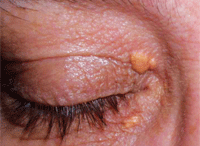Often seen as a purely cosmetic manifestation, yellow lid lesions can now be considered a warning of heart disease or even death, according to researchers who presented their findings at American Heart Association meeting in November.

Patients with xanthelasmata have a much higher risk for heart attack. Photo: Klaus D. Peter, Gummersbach, Germany
In a 33-year prospective study, Denmark researchers found that xanthelasmata (cholesterol lesions on the eyelids) indicate that patients’ risk of a heart attack is increased 51%; the risk of ischemic heart disease is increased 40%; and the risk of death is increased 17%, compared with patients who don’t have xanthelasmata.
To isolate persons with xanthelasmata, researchers analyzed the medical records of 12,939 adults from the general Danish population. Of these patients, 1,903 suffered a heart attack; 3,761 acquired ischemic heart disease; and 8,663 died.
What are the implications of this study for clinical practice? “In the past, when you’d see these rare lesions, you’d refer patients to their primary care physician to check for lipid abnormalities and perhaps to a dermatologist for removal, but this study indicates that we may now have to make another referral,” says Carlo Pelino, O.D., assistant professor at The Eye Institute of the Pennsylvania College of Optometry. “It may now be our responsibility to take it one step further and refer these patients to a cardiologist to determine heart disease risk.”
Awareness of the link between lid lesions and heart disease is key. “Because patients are unaware of the strong correlation between eyelid lesion and heart disease,” lead researcher Mette Christoffersen, Pharm.D., explains, “most of these patients seek out the help of a dermatologist to remove xanthelasmata rather than a cardiologist.”
But, James P. Milite, M.D., chief of oculoplastic and reconstructive surgery at Omni Eye Services, Iselin, N.J., discusses the serum cholesterol implications of xanthelasmata with all his patients.
“In my experience, many of these people are already being managed for hyperlipidemia and/or heart disease,” says Dr. Milite. “The truth is that the greatest risk factor for xanthelasmata is familial, and having normal or controlled cholesterol levels does not prevent recurrence.”

